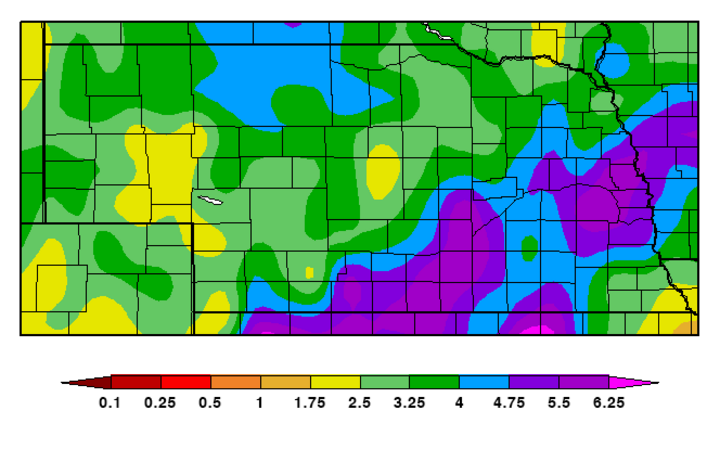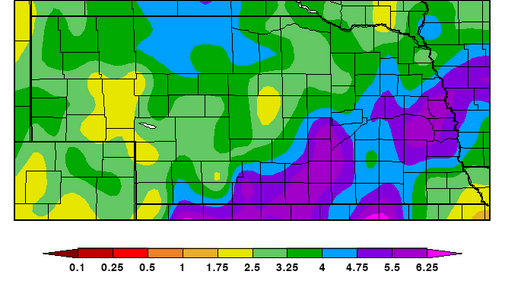Planting progress ground to a halt last week as rains again saturated yet-to-be-planted fields across Nebraska. A good share of our typical corn and soybean area received 4 or more inches in the last two weeks (Figure 1). In Nebraska, 87% of our corn was planted and 52% of our soybean was planted as of May 22. It’s not surprising that these numbers lagged behind normal by 4 and 9 percentage points, respectively, for corn and soybean (May 22 USDA-NASS report). We aren’t alone in our problems this year. Other areas of the U.S. corn production area are poised for a “…historic replant year.” (DTN, May 24, 2017, Seed demand high, Corn replant nears historic levels).

Given these conditions, farmers may be considering changing their course or making adjustments. Following are some points to consider at this point in the season. In a nutshell, we think:
- It is too early to consider changing either corn hybrids or soybean varieties or, for that matter, to consider alternate crops.
- If planting has been delayed, be careful not to plant too shallow.
- Assess flooded fields for stand issues and consider that replanting may be a valid decision depending on your situation. See your crop insurer!
1. It’s too early to consider changing corn hybrids or soybean varieties, or for that matter, changing to another crop.
There is still considerable time left before these become reasonable options. For more information on switching corn hybrids see: "Planting Delays? It’s too Early to Consider Switching Hybrids or Moving to Soybeans.” As planting date delays extend into June use GDD tools for corn (like the U2U tool) to determine risk levels associated with late planting for hybrids with different maturities. Yield penalties with delayed planting will still apply and grain moisture will likely be greater at harvest. After mid-June, consider planting another crop – keeping in mind herbicides already applied.
For soybeans, if planting is delayed past June 15, try the earliest maturity group number recommended for your area. In general this could mean reducing your MG number by 0.5-1.0. Frost before maturity becomes a concern with late June or July plantings. If you use a maturity group much shorter than that, you will sacrifice yield potential. Also, with late planting, narrower row spacing is generally recommended. (See Adjusting for Delayed Soybean Planting for information on row spacing, use of custom planting, and seeding rate.)
On average, as planting dates move into May, both corn and soybean yields drop. What we need to remember is that 2017 is already stacking up as a different year than we’ve experienced lately! Waiting for optimum soil conditions for germination and seedling development is far better than “mudding in” the crop.
2. Don’t plant too shallow.
Planting at least two inches deep allows planters to perform at their optimum in terms of seed placement and seed-vee closing. Planting too shallow may allow the seed zone to dry out and even if seeds have enough moisture to germinate, they may not have enough moisture to emerge. See “Despite Planting Delays, Don’t Plant Too Shallow,” for more information.
3. Assess flooded corn and soybean stands.
Assess your surviving corn and soybean stands after water recedes and plants have had an opportunity to respond.
For more information see: Corn and Soybean Survival in Saturated and Flooded Soils and/or, Corn Survival in Ponded or Flooded Fields.
4. Replanting?
Before replanting, consider whether replanting at this time will provide the yields you need to make it economically viable and talk to your crop insurer.
Unfortunately, yields of both corn and soybean are significantly reduced when planting in early June. For soybean, yield potentials decrease ¼ to 5/8 bushel per acre per day when planting after May 1. (See April 11, 2014 CropWatch, Why planting soybean early improves yield potential). Yield declines when plant stands are reduced below 100,000 plants per acre and yield drops even more drastically when stands fall below 75,000 plants per acre. There is no need to replant if earlier planted soybean fields have at least 75,000 plants per acre and the stand is fairly uniform across the field. Soybeans have multiple growing points and can add branches to compensate for fewer plants per acre. (See this earlier story and the links to two ISU stories on soybean replanting: https://cropwatch.unl.edu/stay-course-when-replanting-soybeans).
For corn, see Table 1 in the May 5, 2017 CropWatch article “Do I need to replant my corn?”. For example, if you replanted between May 25 and June 5 and achieved a stand of 35,000 plants per acre, yield could be about 70% of a similar stand planted in late April to early May. On the other hand, if you planted in late April to early May and hail or flooding or something else reduced plant populations to 20,000 plants per acre, yield potential would be around 63%. The U2U Decision Support Tool can help you select the appropriate maturity for hybrids to reach maturity before a killing frost.
When considering replant for either corn or soybean:
- Determine yield potential of the present stand.
- Estimate replant costs.
- Consider herbicides and weed management.
- Contact your crop insurer.
See the Nebraska Soybean & Corn Pocket Field Guide for more ideas on replanting (pages 29 – 30 for soybean and pages 163 – 166 for corn). A copy of the Guide was mailed to 23,000 Nebraska soybean/corn producers a few weeks ago. If you did not get one, copies will soon be available in Nebraska County Extension Offices.
References & Resources
Previous stories/resources related to this topic, some of which were hyperlinked above:
Adjusting for Delayed Soybean Planting. CropWatch, 2016, N. Mueller, A. Nygren, J. Rees, and J. Specht.
Delayed Corn Planting – Costs and Considerations. CropWatch, 2007, M. Bernards, R. Ferguson, and K. Glewen.
Despite Planting Delays, Don’t Plant Too Shallow. CropWatch, 2016, P. Jasa.
Planting Delays? It’s too Early to Consider Switching Hybrids or Moving to Soybeans. CropWatch, 2016, R. Elmore.
Corn and Soybean Survival in Saturated and Flooded Soils. CropWatch, 2015, R. Elmore and N. Mueller
Assessing Corn Replant Options. CropWatch, 2015, R. Elmore, N. Mueller, and L. Thompson.
Q and A: Should I keep my initial corn stand or replant? CropWatch, 2016, N. Mueller and A. Nygren
Seedling Diseases Developing in Corn. CropWatch, 2016, N. Mueller and T. Jackson-Ziems
Corn Survival in Ponded or Flooded Fields. CropWatch, 2017, R. Elmore
Do I need to replant my corn CropWatch, 2017, J. McMechan and R. Elmore
Why planting soybean early improves yield potential. CropWatch, 2014, R. Elmore et al.
Nebraska Soybean and Corn Pocket Field Guide. CropWatch, 2017, J. Specht, T. Hoegemeyer, et al.

